7 Wonders of the World
 Taj Mahal
Taj MahalDate of construction: Completed c.1648
Location: India
The Taj Mahal is a mausoleum located in Agra, India, built by Mughal Emperor Shah Jahan in memory of his favorite wife, Mumtaz Mahal.
The Taj Mahal is considered the finest example of Mughal architecture, a style that combines elements from Persian, Indian, and Islamic architectural styles. In 1983, the Taj Mahal became a UNESCO World Heritage Site and was cited as "the jewel of Muslim art in India and one of the universally admired masterpieces of the world's heritage."
While the white domed marble mausoleum is its most familiar component, the Taj Mahal is actually an integrated complex of structures. Building began around 1632 and was completed around 1653, and employed thousands of artisans and craftsmen. The construction of the Taj Mahal was entrusted to a board of architects under imperial supervision including Abd ul-Karim Ma'mur Khan, Makramat Khan, and the Persian Ustad Ahmad Lahauri, although Lahauri is generally considered to be the principal designer.
>>more Pictures...(Click to Enlarge)



>>Taj Mahal History:
For centuries, the Taj Mahal has inspired poets, painters and musicians to try and capture its elusive magic in word, colour and song. It is one of the most flawless architectural creations of the world. Since the 17th century, travellers have crossed continents to come and see this ultimate memorial to love, and few have been unmoved by its incomparable beauty.
Taj Mahal stands in the city of Agra, in the northern Indian state of Uttar Pradesh, on the banks of the Yamuna River. It was built in the memory of the beautiful Arjumand Bano Begum, who won the heart of a Mughal prince. She was married at 21 to Emperor Jahangir’s third son Prince Khurram and stayed loyally by his side through good times and bad: in the luxurious royal palaces of Agra as well as the transient tents of war camps.
In AD 1628, Khurram became king after a bloody battle of succession: he took the name Shahjahan or “King of the World” and showered his beloved begum with the highest titles. She became Mumtaz Mahal, the exalted of the palace and Mumtaz-ul-Zamani, the exalted of the Age. But Mumtaz Mahal was not destined to be queen for long.
Taj Mahal Agra
In 1631, Shahjahan went on an expedition to the south and, as always, Mumtaz Mahal accompanied him. But she died in childbirth at Burhanpur. She had borne Shahjahan fourteen children, of whom four sons and three daughters survived. When Mumtaz Mahal died, she was just 39 years old. Shahjahan was inconsolable and contemporary chronicles tell of the royal court mourning for two years. there was no music, no feasting, and no celebration of any kind.
>>more Photos of Taj Mahal...(Click to Enlarge)
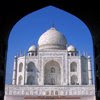


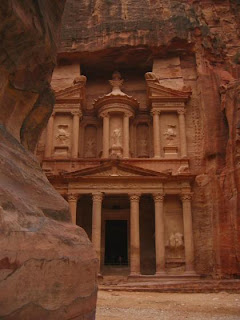 Petra
PetraDate of construction: UnKnown
Location: Jordan
Petra is an archaeological site in the Arabah, Ma'an Governorate, Jordan, lying on the slope of Mount Hor in a basin among the mountains which form the eastern flank of Arabah (Wadi Araba), the large valley running from the Dead Sea to the Gulf of Aqaba. It is renowned for its rock-cut architecture. Petra is also one of the new wonders of the world. The Nabateans constructed it as their capital city around 100 BC.
>>more Pictures of Petra(Click to Enlarge)

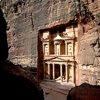
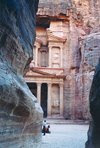
The site remained unknown to the Western world until 1812, when it was introduced to the West by Swiss explorer Johann Ludwig Burckhardt. It was famously described as "a rose-red city half as old as time" in a Newdigate prize-winning sonnet by John William Burgon. UNESCO has described it as "one of the most precious cultural properties of man's cultural heritage." In 1985, Petra was designated a World Heritage Site.
>>more Photos of Petra(Click to Enlarge)



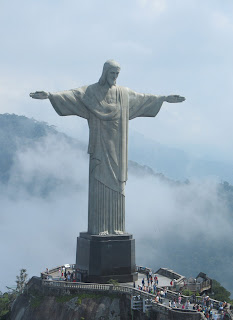 Christ the Redeemer
Christ the RedeemerDate of construction: Opened 12 October 1931
Location: Brazil
Christ the Redeemer is a statue of Jesus Christ in Rio de Janeiro, Brazil. The statue stands 30 metres (98 ft) wide and 38 metres (120 ft) tall with its pedestal. It weighs 635 tons (700 short tons), and is located at the peak of the 700 metres (2,300 ft) Corcovado mountain in the Tijuca Forest National Park overlooking the city. It is one of the tallest of its kind in the world. The statue of Cristo de la Concordia in Cochabamba, Bolivia, is slightly taller, standing at 34.20 metres (112.2 ft) tall and 40.44 metres (132.7 ft) tall with its 6.24 metres (20.5 ft) pedestal. A symbol of Christianity, the statue has become an icon of Rio and Brazil. The statue of Christ the Redeemer is a very important symbol of Brazil's Christianity. It is made of reinforced concrete and soapstone.
>>more Pictures..(Click to Enlarge)



>>christ the redeemer History:
The idea for erecting a large statue atop Corcovado was first suggested in the mid 1850s, when Catholic priest Pedro Maria Boss requested financing from Princess Isabel to build a large religious monument. Princess Isabel did not think much of the idea and it was completely dismissed in 1889, when Brazil became a Republic, with laws mandating the separation of church and state. The second proposal for a large landmark statue on the mountain was made in 1921 by the Catholic Circle of Rio. The group organised an event called Semana do Monumento to attract donations and collect signatures to support the building of the statue. The donations came mostly from Brazilian Catholics. The designs considered for the "Statue of the Christ" included a representation of the Christian cross, a statue of Jesus with a globe in his hands, and a pedestal symbolizing the world. The statue of Christ the Redeemer with open arms was chosen.
>>more Images of christ the redeemer...(Click to Enlarge)

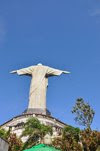

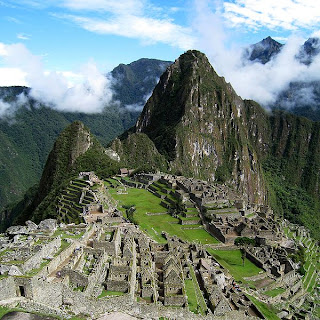 Vista de Machu Picchu
Vista de Machu PicchuDate of construction: c.1450
Location: Peru
Machu Picchu is a pre-Columbian Inca site located 2,430 metres (8,000 ft) above sea level[1]. It is situated on a mountain ridge above the Urubamba Valley in Peru, which is 80 kilometres (50 mi) northwest of Cuzco and through which the Urubamba River flows. Often referred to as "The Lost City of the Incas", Machu Picchu is one of the most familiar symbols of the Inca Empire.
>>more Pictures...(Click to Enlarge)



>>Machu picchu history:
Hiram Bingham, explorer and professor of South American history first crossed the PeruHiram Binghamvian mountains in February 1909, the wettest month ofthe year, making his travels difficult. However, his visit to the ruins of Choquequirao stimulated his interest in the Incas. In 1911 he returned with the Yale Peruvian Expedition which was actually intended to visit the Urubamba River and surrounds, to find the last capital of the Incas.
Bingham studied writings of the Conquest and colonial documents, with the intention of knowing exactly where they should head. He had also heard about a mysterious lost city in the jungle, but no one in Cusco gave credit to these comments because it was already thought that the last capital of the Incas was Choquequirao.
The expedition set off following the course of the Urubamba River, exploring series of ruins along the way. On July 23 1911, Bingham arrived at Mandor where he met the peasant farmer Melchor Arteaga who told Bingham about the existence of two Inca sites, Machu Picchu and Wayna Picchu.
>>more Photos of Machu picchu...(Click to Enlarge)



>>Machu picchu Mystery:
Machu Picchu (commonly misspelled Machu Pichu) is a Quechua language name meaning "Old Peak". It was a Pre-Columbian city located at 2,430 m (7,970 ft) altitude on a mountain ridge above the Urubamba Valley in Peru, about 70 km (44 mi) northwest of Cusco. Machu Picchu was a city of the Inca Empire, near impenetrable and originally accessible only by the Inca trail, and never discovered or destroyed by the Spanish Conquistadores.
Machu Picchu is probably the most familiar symbol of the Inca Empire. It is often referred to as "The Lost City of the Incas". The site was designated as a World Heritage Site in 1983 when it was described as "an absolute masterpiece of architecture and a unique testimony to the Inca civilization".
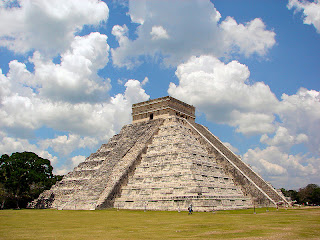 Chichen Itza
Chichen ItzaDate of construction: c.600
Location: Mexico
Chichen Itza is a large pre-Columbian archaeological site built by the Maya civilization located in the northern center of the Yucatán Peninsula, in the Yucatán state, present-day Mexico.
>>more pics...(Click to Enlarge)



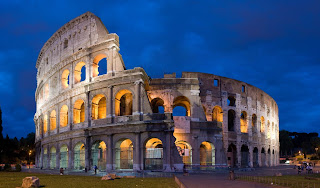 Roman Colosseum
Roman ColosseumDate of construction: Completed 80 CE
Location: Italy
The Colosseum or Roman Coliseum, originally the Flavian Amphitheatre is an elliptical amphitheatre in the center of the city of Rome, Italy, the largest ever built in the Roman Empire. It is one of the greatest works of Roman architecture and Roman engineering.
>>more Pics..(Click to Enlarge)






>>Facts about roman colosseum:
The Roman coliseum was originally known as the "Flavian Amphitheater". It is a massive and huge building of the ancient Roman Empire. The Roman Emperor Vespasian initiated the construction of the Roman Coliseum in the year 70 AD. He was the founder of the Flavian dynasty.
The Roman coliseum was completed in 80 AD after the death of the emperor. The next heir to the throne, Emperor Titus, opened it to the public. It is said, the inaugural ceremony lasted for more than 100 days.
Coliseum was built near the giant statue of Colossus and occupied part of the Nero’s park. The current name was derived from the statue of Colossus.
The Roman Coliseum is an amphitheater that has the capacity to hold 50,000 people at a time. Originally, it had four floors, where the first three had wide arched entrances and the fourth floor had rectangular doorways.
The height of each floor is approximately between 32 to 42 feet. The total height of the entire structure is roughly 144 feet. The size of the arena is 79 x 45 meters. In Latin "arena" means, "sand". The arena of the Coliseum consisted of wood and sand. There were tall nets along the sides of the Coliseum to protect the spectators.
The Roman coliseum is a massive building. Travertine is used to build the exterior of the building while tufa and brick were used to construct the interiors. The pedestals were made of marble blocks. The total amount of marbles used for the construction was approximately 100,000 cubic meters. The historical evidences reveal 200 bullock carts were used to transport the marble to the construction site.
The Roman Coliseum had 76 entrances and an additional 4 entrances reserved for the emperor, nobles and the gladiators.
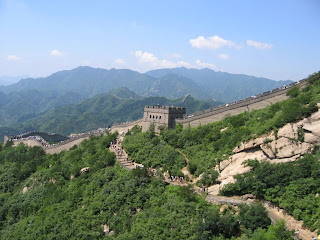 Great Wall of China
Great Wall of ChinaDate of construction: 5th century BCE – 16th century CE
Location: China
The Great Wall of China is a series of stone and earthen fortifications in northern China, built, rebuilt, and maintained between the 5th century BC and the 16th century to protect the northern borders of the Chinese Empire from Xiongnu attacks during various successive dynasties.
>>more Pics of Great Wall of China...(Click to Enlarge)






>>Facts about the Great Wall of China:
The Great Wall of China was never built at one go. Initially, powerful regional kingdoms built their own walls, which were solely meant for their own defensive military requirements. The earliest known sections of the Great Wall of China were constructed in the 7th century BC. After the emergence of unified China in the Qin Dynasty (221-206 BC), the Great Wall of China became a collective entity. Around 1700 years after this the Great Wall of China was enlarged and enhanced.
The Great Wall of China stretches over approximately 6,400 km across a variety of terrains like mountains, plateaus and desserts.
The width of the Great Wall of China is different at various positions and hence ranges from 15 to 30 feet.
The Great Wall of China has an average height of about 25 feet.
* Great wall of china from moon
* Great wall of china from outer space
 Great Pyramid of Giza
Great Pyramid of GizaDate of construction: Completed c.2560 BCE
Location: Egypt
The Great Pyramid of Giza (also called the Khufu's Pyramid, Pyramid of Khufu, and Pyramid of Cheops) is the oldest and largest of the three pyramids in the Giza Necropolis bordering what is now Cairo, Egypt, and is the only one of the Seven Wonders of the Ancient World that survives substantially intact. It is believed the pyramid was built as a tomb for Fourth dynasty Egyptian King Khufu (Cheops in Greek) and constructed over a 20 year period concluding around 2560 BC. The Great Pyramid was the tallest man-made structure in the world for over 3,800 years.
Pictures from Google Earth...(Click to Enlarge)

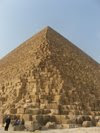



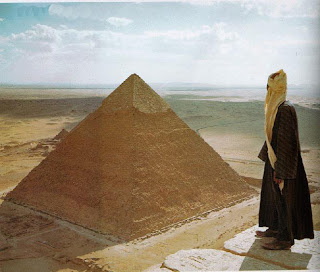 Great Pyramid of Giza Pictures
Great Pyramid of Giza PicturesGreat Pyramid of Giza Facts:
The Great Pyramid at Giza is an awesome sight, thirty times larger than the Empire State Building(in mass), the Pyramid's features are so large they can be seen from the Moon. The oldest structure in existence, having been started 4,617 years ago, it is the sole remnant of the Seven Wonders of the World.
The Great Pyramid did not always look as "rough" as it does today. Originally it was encased with a layer of tight-fitting, highly polished 20-ton stone slabs.W.M. Flinders Petrie determined the exact dimensions of the sides of the Pyramids and he found that they were almost exactly the same length to a accuracy of 0.1 +/- inch.
The Great Pyramid is the most comprehensively studied building in the world. It sited at the northern edge of the Giza plateau. It was estimated that 2,300,000 blocks of stone, weighing between 2-70 tons each, were used in its construction, but recent computer calculations estimated the total number of slabs to be 590,712. The mortar used is of an unknown origin. It has been analyzed and it's chemical composition is known but even using today techniques it can't be reproduced.
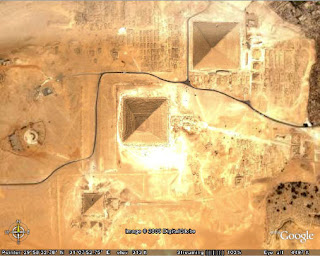 google satellite image of giza pyramids
google satellite image of giza pyramids>>more Pictures of Pyramids...

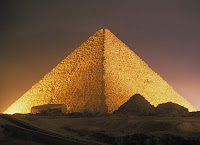

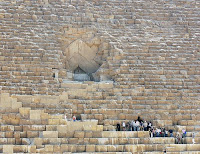


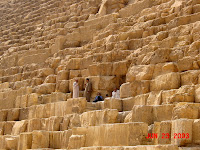


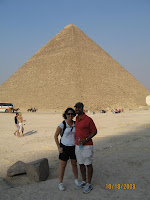

Comments
Post a Comment